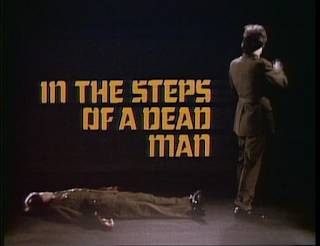The story...
George and Betty Cornfield are devastated when they discover that their son Tommy has been killed on army service. Their mood is lifted a little though when a soldier called Marty Fuller arrives at their home. He says he was an army friend of Tommy who helped him in his final moments. The Cornfields and Marty build a close bond and Marty also develops a close friendship with Tommy's fiancee Sheila, helping her to cope with her loss.
The only person who doesn't seem won over by Marty is Sheila's American student friend Grace Worth. She finds it strange that Tommy never mentioned his supposed close friend Marty. She checks Tommy's diary and notices some alarming entries about his relationship with "M" who she presumes is Marty. Soon after further tragedy strikes and these terrible events drive the Cornfields even closer to Marty but maybe that is something they will regret...
Review
While opinions are mixed on the quality of the previous week's Death To Sister Mary there is no difference of opinion on this episode which is widely considered one of the Thriller greats, certainly up there with both A Coffin for the Bride and I'm the Girl He Wants to kill at the start of Series 3 which are also considered among the best in the show's history..
The story is a captivating one. Tommy's parents and Sheila suffer a terrible tragedy which turns their happy lives upside down. They all struggle to cope - most of all George, his father. However along comes Marty to seemingly give them hope. He talks so warmly about Tommy and brings happiness and purpose back into their lives. In fact he seems to be a new Tommy who can take his place as the son and partner they have lost.
However the viewers are all too clear that Marty is not what he seems although the exact nature of his relationship to Tommy and his motivations take time to be revealed. Marty shows a reluctance to be reminded of Tommy that should have got some alarm bells ringing. Grace - maybe with the benefit of being an outsider - astutely sees that there is something amiss with Marty and his supposed friendship with Tommy but the family are oblivious. She tries to warn Sheila but the ultimate consequences are dreadful and culminate in one of the most terrifying scenes in Thriller with Denise Buckley's acting especially impressive.
 |
| Sheila (right) finds Grace's allegations about Marty hard to take |
The battle of wits between Grace and Marty is great viewing. There are echoes of the relationship between Mark Walker and Stella in A Coffin for the Bride as an attractive, charming man aims to embark on a relationship with an attractive young woman while he goes about his "business". Grace proves hard to get but with the Cornfields still on his side Marty is able to move closer to his ultimate goal - unless Grace and other forces can stop him.
Matters take a remarkable twist late on. This ending is one of the most memorable in Thriller and certainly one of the most morally provocative. "Natural" or poetic justice may seem to be very much at work but the moral quandary remains.
This is a close
to flawless episode with so much in its favour. The characters are top class.
The Cornfields are a loving, devoted couple and Sheila cut from a similar
cloth. However it is Marty and Grace who make the greatest impressions. He is
another highly complex villain. His actions seem appallingly vindictive, not
only towards Tommy but maybe even more so to the trusting, vulnerable family.
He is a master of deception and manipulation. It is clear though that he has a
very troubled mind, maybe destabilised by warfare, possibly by a rather more
unpleasant side to Tommy than is imagined. Maybe his own lack of family lies
behind such destructive behaviour - he cannot cope with the happiness of
others. Grace wins admiration for her perceptiveness, persistence and
ultimately bravery in pursuing such a dangerous man. It is possible, as he suggests,
that she is attracted to him. It certainly appears so by her reaction on first
seeing him but she resists temptation and soon gets suspicious. Of the
ancillary characters the steely Sergeant O'Hara is clearly not a man to be
messed with. Throughout the episode he is thwarted in his attempts to find Marty but a chance meeting may well lead to the outcome he desires.
There are many great performances. Richard Vernon, Faith Brook, John Nolan, Skye Aubrey and Derek Anders (O'Hara) are all excellent. Denise Buckley particularly comes into her own as the doubts about Marty kick in and her anguish and mixed emotions are expertly handled. Fine direction assists and even some military-themed incidental music by Laurie Johnson heightens the atmosphere but the exceptional script is the key. Remarkably the brilliant third series still had another exceptional episode to follow.
Notes
Some listings for this episode referred to Tommy Cornfield having been killed in action in Northern Ireland. No reference is made to this on-screen although it may have been referenced in script background or publicity material.
TV Movie title-watch
Perhaps it seems fitting that one of Thriller's finest episodes should also have new movie titles and music that are also well above the norm. The TVM version was the the only one available for many years and the titles start with an excellent, chilling scene of an apparently stricken soldier rising up from the dead accompanied by suitably military-styled music and battle sounds, then leading to a more eerie score as "Marty" makes his plans.



















